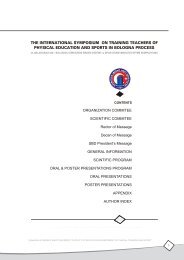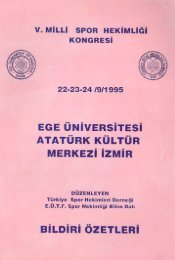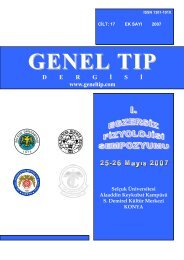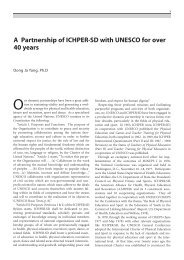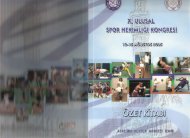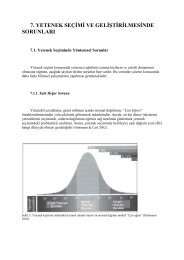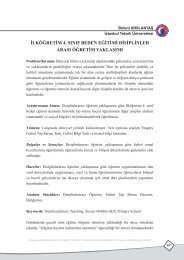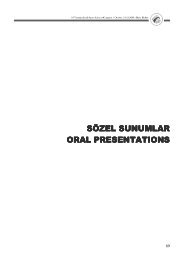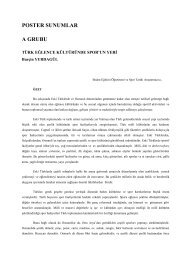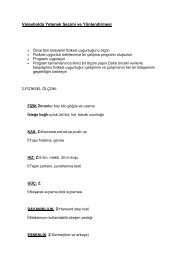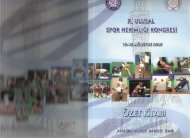KARDÄ°YORESPÄ°RATUVAR EGZERSÄ°Z TESTLERÄ° ... - Spor Bilim
KARDÄ°YORESPÄ°RATUVAR EGZERSÄ°Z TESTLERÄ° ... - Spor Bilim
KARDÄ°YORESPÄ°RATUVAR EGZERSÄ°Z TESTLERÄ° ... - Spor Bilim
You also want an ePaper? Increase the reach of your titles
YUMPU automatically turns print PDFs into web optimized ePapers that Google loves.
7.ULUSLARARASI SPOR BİLİMLERİ KONGRESİ27-29 EKİM 2002KONGRE - PANELLERequally responsive to intermittent and continuous endurance training protocols. A particularly poor response toaerobic training in prepubertal soccer players might be attributable to low androgen levels for hypertrophy ofcardiac muscle, stimulation of red blood cells and haemoglobin, and synthesis of metabolic enzymes.It is incorrect for young players to be viewed simply as miniature adults and training programmes used byadult professional teams should not be transferred to them without appropriate modifications. There are alsosubstantial ethical issues linked with the exploitation of young players for commercial gain by transferring themto the richer professional clubs for specialised training. The traffic of young foreign players by professional‗agents‘ to European nations without any guarantee of subseqent employment by any of the professional clubsis a practice that contravenes normal sports ethics.2.2 Anaerobic power and muscle strengthAnaerobic power and capacity are not so well developed in children compared to aerobic power. Thisdifference is reflected in the relative contribution of aerobic and anaerobic mechanisms in ‗all-out‘ efforts. Inchildren, a 6-minute run is dependent almost entirely on aerobic metabolism. For a maximal effort of less than60 seconds, children derive 60% of the total energy from anaerobic sources compared to 80% in adults (seeBorms, 1986). The poorer anaerobic capacity in children is reflected in low levels of lactate production duringintense exercise bouts and suggests a low glycolytic rate. There is especially limited potential in theprepubescent child for developing the anaerobic system. Evidence from magnetic resonance spectroscopy hasconfirmed that children are less able than adults to effect ATP rephosphorylation in anaerobic pathways duringhigh intensity exercise (Zanconato et al., 1993). Pre-adolescents accumulate lower lactate levels in their bloodthan do adults during high intensity exercise but they recover much faster than men following short-term (30 s)intense exercise. Anaerobic capacities increase progressively during maturation until reaching adult levels afterthe teenage years.Responses to strength training also are small in the prepubescent child although there are few goodstudies to substantiate this belief (see Bar-Or, 1988). Until testosterone levels increase in boys at the time ofthe adolescent growth spurt, muscle mass remains below the percentage of total body mass observed in adults.Gains in pre-pubertal strength gains are mainly due to improved neuromuscular co-ordination. The relativemuscle mass increases after sexual maturation as muscle growth is stimulated by androgonic hormones.Strength gains also accompany the rise in testosterone levels. Where weight–training is undertaken by youngplayers, submaximal loads are recommended, in view of potential compressive loading on the growing skeleton.Emphasis should be placed more on the number of repetitions than on heavy resistances and maximal efforts.3702.3 Speed and co-ordinationThe building blocks of gross motor skills are laid down in the course of the child‘s habitual activity andearly exposures to playing soccer. Development of running speed accelerates in two phases, first at about 8years in both sexes, the second at about aged 12 for girls and between 12 and 15 for boys. The former isrelated to the maturing of the nervous system and improved co-ordination of arm and leg muscles: a variety ofphysical activities has been recommended to stimulate whole-body co-ordination at this age (Borms, 1986).The latter improvement is related to the increase in body size and muscle performance, muscle mass increasingslightly after peak height velocity is reached. An obvious ‗awkwardness‘ may occur at this period ofadolescence and is thought to be linked with disproportionate increases in leg length relative to trunk length.Only 10-30% of adolescent boys are affected and the effects are transient (Beunen and Malina, 1988).Selective training for sport (including soccer) is probably not necessary prior to this phase of development,although this recommendation does not apply to a formal organisation of activities in the context of playing forfun to support motor skills acquisition. Nevertheless some exposure to games skills is important at an earlyage, since Elliott et al. (1980) reported that the movement and muscle activity patterns of young soccer playerswas evident by age 11 years.The extent to which anthropometric and physiological criteria are appropriate markers of football talenthas remained largely unresolved. This gap in knowledge is due in part to the fact that it is invalid to extrapolate



